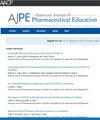按学年分列的药剂学专业学生对药剂学课程文化能力的自我评价。
IF 3.8
4区 教育学
Q1 EDUCATION, SCIENTIFIC DISCIPLINES
引用次数: 0
摘要
目的:本研究旨在探讨药剂学专业学生文化能力评估(CCAPS)的调查结果:本研究旨在探讨药学专业学生文化能力评估(CCAPS)调查的结果,以确定一所药学院课程中文化能力内容可改进之处:开发了 39 个项目的 CCAPS 调查表,并在 2022 年 7 月(授课课程结束后,四年级学生开始实习轮转时)至 2022 年 10 月(一年级、二年级和三年级学生秋季学期开始时)期间对药学博士(PharmD)学生进行了调查。文化能力自我认知项目选自文化能力评估工具和临床文化能力问卷项目。问卷以匿名方式收集,并使用 SPSS 按学年进行汇总分析:541 名学生参与了调查,其种族包括白人/欧美人(26.6%)、东亚/南亚/东南亚人(17%、18.5%、5.4%)、阿拉伯人/中东人(17.9%)、非洲裔美国人/黑人(6.7%)和西班牙裔美国人(6.1%)。三分之二的受访者认为自己 "非常或极具 "文化胜任能力,78%的受访者表示与不同文化背景的病人互动时感到舒适。在评估学生与英语水平有限或因文化原因拒绝用药的患者进行交流的舒适度的问题上,学生得分较低。与其他年级的学生相比,四年级的学生表示在日常生活中练习与文化胜任能力相关的技能更加困难:每年使用 CCAPS 调查有助于评估不同学年药学专业学生的文化胜任能力,并找出课程中与文化胜任能力相关的不足之处。本文章由计算机程序翻译,如有差异,请以英文原文为准。
Pharmacy Students’ Self-Reported Cultural Competence in a Pharmacy Curriculum by Academic Year
Objective
This study aims to explore the results of a Cultural Competency Assessment of Pharmacy Students (CCAPS) survey to identify areas where cultural competence content in one college of pharmacy curriculum can be improved.
Methods
The 39-item CCAPS survey was developed and administered to Doctor of Pharmacy (PharmD) students from July 2022 (after the end of the didactic curriculum and at the beginning of experiential rotations for fourth-year students) to October 2022 (at the beginning of the fall semester for first-year, second-year, and third-year students). Self-perception of cultural competency items were selected from the Cultural Competence Assessment Instrument and the Clinical Cultural Competency Questionnaire items. Responses were collected anonymously and analyzed in the aggregate by academic year using SPSS.
Results
A total of 541 students participated, with ethnicities including White/European American (26.6%), East/South/Southeast Asian (17%, 18.5%, 5.4%), Arab/Middle Eastern (17.9%), African American/Black (6.7%), and Hispanic (6.1%). Two-thirds of respondents identified as “very or extremely” culturally competent, and 78% reported comfort interacting with culturally diverse patients. Students scored lower on questions that assessed their comfort interacting with patients who have limited English proficiency or who refuse medications due to cultural reasons. Students in the fourth year reported more difficulty practicing skills related to cultural competency in their daily lives compared with students in other years.
Conclusion
Using the CCAPS survey annually could help evaluate the cultural competency of pharmacy students across different academic years and identify gaps in the curriculum related to cultural competency.
求助全文
通过发布文献求助,成功后即可免费获取论文全文。
去求助
来源期刊
CiteScore
4.30
自引率
15.20%
发文量
114
期刊介绍:
The Journal accepts unsolicited manuscripts that have not been published and are not under consideration for publication elsewhere. The Journal only considers material related to pharmaceutical education for publication. Authors must prepare manuscripts to conform to the Journal style (Author Instructions). All manuscripts are subject to peer review and approval by the editor prior to acceptance for publication. Reviewers are assigned by the editor with the advice of the editorial board as needed. Manuscripts are submitted and processed online (Submit a Manuscript) using Editorial Manager, an online manuscript tracking system that facilitates communication between the editorial office, editor, associate editors, reviewers, and authors.
After a manuscript is accepted, it is scheduled for publication in an upcoming issue of the Journal. All manuscripts are formatted and copyedited, and returned to the author for review and approval of the changes. Approximately 2 weeks prior to publication, the author receives an electronic proof of the article for final review and approval. Authors are not assessed page charges for publication.

 求助内容:
求助内容: 应助结果提醒方式:
应助结果提醒方式:


